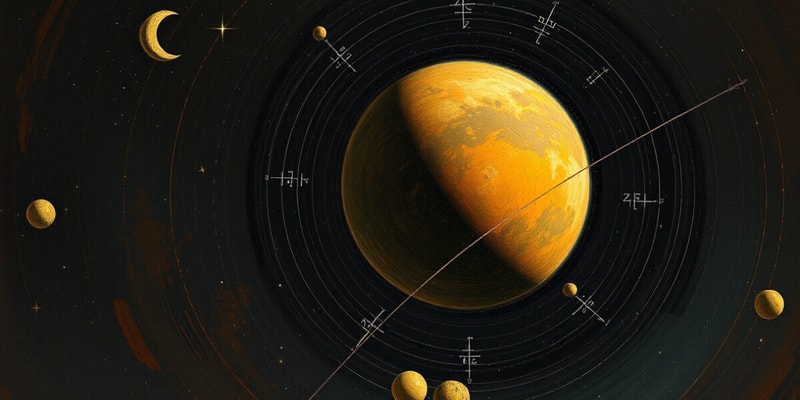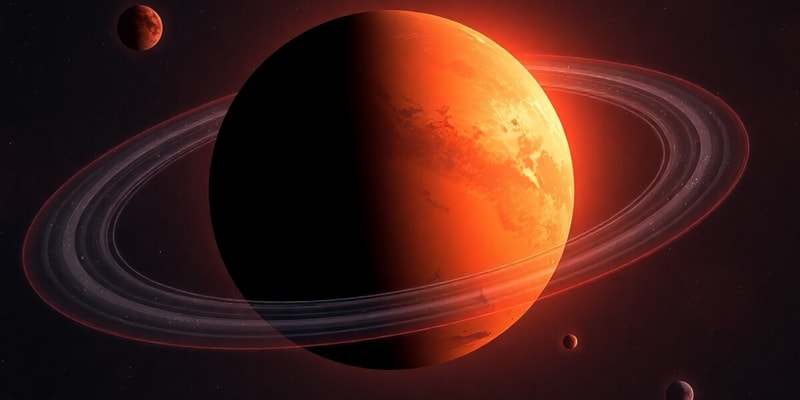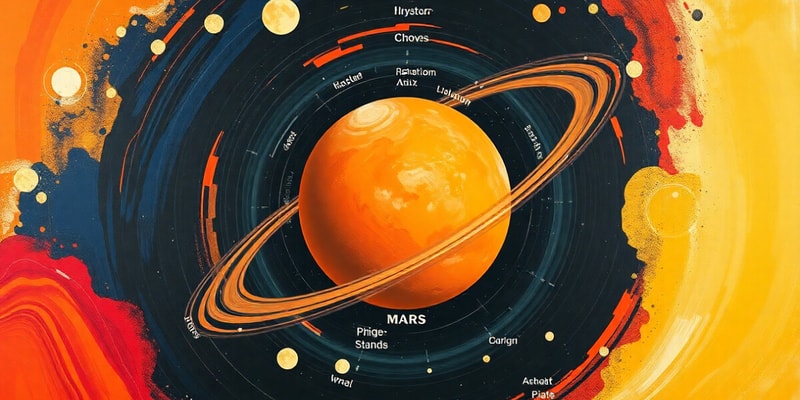Podcast
Questions and Answers
The apparent change in the direction of the motion of Mars is known as ______ motion.
The apparent change in the direction of the motion of Mars is known as ______ motion.
retrograde
Eudoxus of Cnidus created the first model of a ______ Universe.
Eudoxus of Cnidus created the first model of a ______ Universe.
Geocentric
According to Aristarchus of Samos, the moon orbits around the ______.
According to Aristarchus of Samos, the moon orbits around the ______.
Earth
The model that describes planets taking circular orbits around a fixed sun is known as the ______ model.
The model that describes planets taking circular orbits around a fixed sun is known as the ______ model.
Signup and view all the answers
In Eudoxus’ model, the orbits were fixed and celestial bodies were not ______.
In Eudoxus’ model, the orbits were fixed and celestial bodies were not ______.
Signup and view all the answers
Inferior planets are defined as ______ and Venus.
Inferior planets are defined as ______ and Venus.
Signup and view all the answers
In Eudoxus’ model, the modification called ______ involves small circles that move along the deferent.
In Eudoxus’ model, the modification called ______ involves small circles that move along the deferent.
Signup and view all the answers
The imaginary point where the Sun, Moon, and planets rotate is called the ______.
The imaginary point where the Sun, Moon, and planets rotate is called the ______.
Signup and view all the answers
Celestial bodies follow a perfect shape known as the ______
Celestial bodies follow a perfect shape known as the ______
Signup and view all the answers
The observed phenomenon where planets appear to move backward is known as ______ motion.
The observed phenomenon where planets appear to move backward is known as ______ motion.
Signup and view all the answers
Tycho Brahe made precise observations of heavenly bodies before the invention of the ______.
Tycho Brahe made precise observations of heavenly bodies before the invention of the ______.
Signup and view all the answers
Kepler developed simple laws that accounted for the observations of ______ motion.
Kepler developed simple laws that accounted for the observations of ______ motion.
Signup and view all the answers
Newton introduced the notion of ______, the point in a planet's orbit closest to the sun.
Newton introduced the notion of ______, the point in a planet's orbit closest to the sun.
Signup and view all the answers
Newton's first law is known as the law of ______.
Newton's first law is known as the law of ______.
Signup and view all the answers
The lack of ______ for stars was a concern for proponents of heliocentrism.
The lack of ______ for stars was a concern for proponents of heliocentrism.
Signup and view all the answers
Johannes Kepler is known for formulating the ______ laws of planetary motion.
Johannes Kepler is known for formulating the ______ laws of planetary motion.
Signup and view all the answers
The orbits are ______
The orbits are ______
Signup and view all the answers
A body at rest will remain at rest, and a body in motion will remain in motion unless it is acted upon by an ______ force.
A body at rest will remain at rest, and a body in motion will remain in motion unless it is acted upon by an ______ force.
Signup and view all the answers
Planets cover equal areas in ______ time.
Planets cover equal areas in ______ time.
Signup and view all the answers
A planet’s orbital period is proportional to the size of its ______.
A planet’s orbital period is proportional to the size of its ______.
Signup and view all the answers
The acceleration of the object is directly proportional to the ______ and inversely proportional to the mass.
The acceleration of the object is directly proportional to the ______ and inversely proportional to the mass.
Signup and view all the answers
The higher mass, the more ______ occurs between two objects.
The higher mass, the more ______ occurs between two objects.
Signup and view all the answers
In the equation F = G (m1 m2) / r^2, r is the ______ between the two objects.
In the equation F = G (m1 m2) / r^2, r is the ______ between the two objects.
Signup and view all the answers
If r decreases, attraction will ______.
If r decreases, attraction will ______.
Signup and view all the answers
Einstein's theory challenged Newton's picture of universal ______.
Einstein's theory challenged Newton's picture of universal ______.
Signup and view all the answers
In swimming, you push the fluid ______ to swim forward.
In swimming, you push the fluid ______ to swim forward.
Signup and view all the answers
Special relativity is concerned with comparing physical effects from different observer positions in terms of ______.
Special relativity is concerned with comparing physical effects from different observer positions in terms of ______.
Signup and view all the answers
According to general relativity, gravity is not a force but a distortion in the shape of ______.
According to general relativity, gravity is not a force but a distortion in the shape of ______.
Signup and view all the answers
A hypothesis is an educated guess and a minimal explanation of a ______.
A hypothesis is an educated guess and a minimal explanation of a ______.
Signup and view all the answers
Henry Cavendish proved the value of G = 6.67 x 10-11 N m²/kg², which is known as the gravitational ______.
Henry Cavendish proved the value of G = 6.67 x 10-11 N m²/kg², which is known as the gravitational ______.
Signup and view all the answers
In physics, a ______ is a quantity that has both magnitude and direction.
In physics, a ______ is a quantity that has both magnitude and direction.
Signup and view all the answers
In contrast, a ______ has magnitude but no direction.
In contrast, a ______ has magnitude but no direction.
Signup and view all the answers
According to Newton's second law, the formula for force is ______ = mass × acceleration.
According to Newton's second law, the formula for force is ______ = mass × acceleration.
Signup and view all the answers
During free-fall, an object experiences ______, resulting in zero weight.
During free-fall, an object experiences ______, resulting in zero weight.
Signup and view all the answers
When an elevator accelerates upwards, the apparent ______ of a person inside increases.
When an elevator accelerates upwards, the apparent ______ of a person inside increases.
Signup and view all the answers
Newton's laws cannot explain the ______ movement of mercury around the Sun.
Newton's laws cannot explain the ______ movement of mercury around the Sun.
Signup and view all the answers
In Case 2, when the elevator is going down, the weight is ______.
In Case 2, when the elevator is going down, the weight is ______.
Signup and view all the answers
Study Notes
Retrograde Motion and Early Models
- Retrograde motion of Mars is the apparent backward movement due to the differing speeds of Earth and Mars.
- Eudoxus of Cnidus proposed the first geocentric model, asserting that celestial bodies travel in uniform circular orbits around Earth.
- His model included concentric circles (deferents), small circles (epicycles), and an imaginary point called equant for motion variations.
- He noted changes in brightness and size of celestial bodies but could not reconcile these with his model.
Heliocentric Model
- Aristarchus of Samos introduced the heliocentric model with Earth and planets orbiting a fixed Sun, proposing that the Moon orbits Earth.
- Stellar parallax reflects the apparent shift of distant objects due to Earth's motion.
- Nicolaus Copernicus refined the heliocentric theory, emphasizing uniform circular orbits around the Sun, with Earth at a faster orbital speed leading to retrograde motion.
Important Contributions from Astronomers
- Claudius Ptolemy enhanced the geocentric model but failed to explain retrograde motion satisfactorily and could not observe stellar parallax due to distance.
- Tycho Brahe conducted precise astronomical observations before telescopes, discovering lunar craters, sunspots, moons of Jupiter, and phases of Venus, implying a broader view of the cosmos.
- Johannes Kepler formulated three laws of planetary motion, providing evidence for elliptical orbits and relationships between a planet's distance from the Sun and its orbital period.
Newton's Fundamental Laws and Gravitation
- Isaac Newton introduced laws of motion and universal gravitation, explaining gravitational forces as proportional to masses and inversely proportional to the square of the distance between objects.
- He defined key terms such as perihelion (closest point to the Sun) and aphelion (farthest point), clarifying planetary movements.
Laws of Motion
- Newton's First Law (Law of Inertia): An object remains at rest or in uniform motion unless acted upon by a net external force.
- Newton's Second Law (Law of Acceleration): Force equals mass times acceleration (F=ma), demonstrating the relationship between force, mass, and acceleration.
- Newton's Third Law (Law of Action and Reaction): For every action, there is an equal and opposite reaction; forces between two objects are equal in magnitude and opposite in direction.
Vectors and Scalars
- Scalars are quantities with magnitude only, whereas vectors have both magnitude and direction.
- Examples of vectors include velocity, acceleration, and force.
Einstein’s Relativity
- Albert Einstein challenged Newton's gravitational framework with his theory of relativity.
- Special relativity analyzes physical effects from different observers' perspectives regarding speed and direction.
- General relativity describes gravity as the curvature of space caused by mass, rather than a traditional force.
Definitions of Scientific Concepts
- Hypothesis: An educated guess or preliminary explanation of phenomena.
- Law: A statement describing what happens under specific conditions based on repeated trials.
- Theory: A well-substantiated explanation of certain phenomena, providing insights into why events occur.
Studying That Suits You
Use AI to generate personalized quizzes and flashcards to suit your learning preferences.
Description
Explore the fascinating concept of retrograde motion as it applies to Mars in this Science 10 overview. Understand how the apparent change in direction occurs due to differences in orbital speeds. Delve into the implications this phenomenon has for our understanding of planetary motion.




